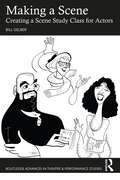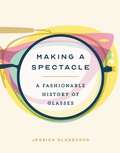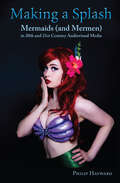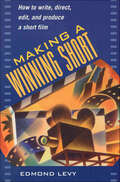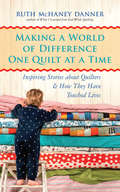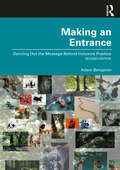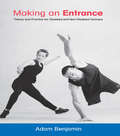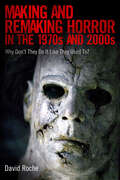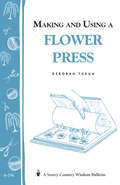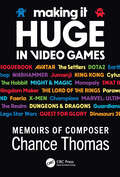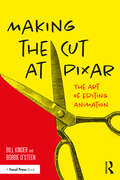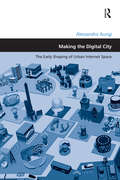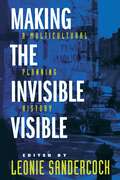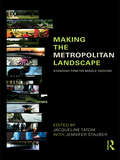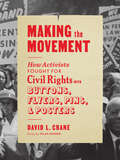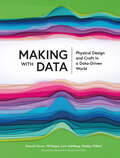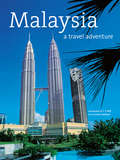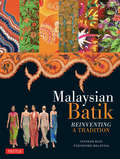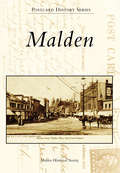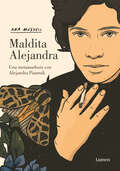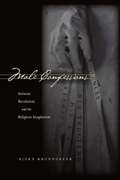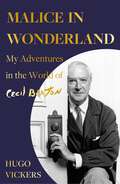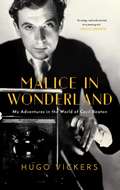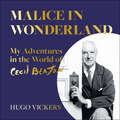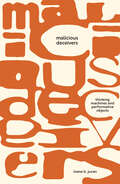- Table View
- List View
Making a Scene: Creating a Scene Study Class for Actors (ISSN)
by Bill GelberBased on the author’s decades of teaching, pedagogical and theatrical research, and his professional experience as actor and director, Making a Scene: Creating a Scene Study Class for Actors offers a pedagogical approach to rehearsal scenes as a primary tool for diagnosis and actor improvement.This volume carefully lays out the case for thinking deeply and critically about the nature of every facet of an acting class: the environment of the classroom, the choice of material for performing, diagnostic tools for responding to scene sessions, and means for engaging all students. This study includes suggestions for a teacher’s philosophy towards the work; a justification for implementing games, improvisations, and etudes; suggestions for resources for exercises both basic and complex; and a brief discussion on approaches to period styles material and connecting it to contemporary student life and issues.Addressed to both the beginning theatre teacher and the seasoned educator, this will be an essential book for anyone seeking to update their work with performers in private studios, high school settings, or in higher education.
Making a Spectacle: A Fashionable History of Glasses
by Jessica GlasscockFrom 13th century Franciscan monks to Beyoncé in Black is King, Making a Spectacle charts the fascinating ascension of eyeglasses—from an unsightly but useful tool to fashion's must-have accessory.The power of glasses to convey a range of vivid messages about their wearers have made them into a billion-dollar business that appeals to cool kids and rock stars, and those who want to be like them, but the fashionable history of eyeglasses is fraught with anxiety and drama. At the beginning of the 20th century, the assessment in Vogue and Harper's Bazaar was that spectacles were "invariably disfiguring." Invisibility was the best option, and glasses were only to be put on once the lights at the opera went dark.While variations of that glasses-shaming sentiment appeared at regular intervals over the next 100 years or so, eyeglasses continued to evolve into an endless array of shapes, colors, purposes, and personalities. Once sunglasses took off in the 1930s, the magazine editorial made glasses a conspicuous part of the fashion narrative. Eyeglasses went to the ski slopes, the stables, the beach, the Havana hotel. Plastic innovations made a candy-colored rainbow of cat-eyes and "starlet" styles possible. Suddenly, everyone had the opportunity to look like Jackie O on vacation in Capri.Making a Spectacle traces contemporary high fashion frames back to their origins: the military aviator, the glam cat eye, the nerdly Oxford, the high-tech shield, the fanciful butterfly, the lowly rimless, and other styles all make an appearance. Featuring interviews with influential designers, makers, and purveyors of glasses including Adam Selman, Kerin Rose Gold, and l.a. Eyeworks, Making a Spectacle also takes a look at today's most cutting edge eyewear, showing the reader the latest and most innovative ways to see and be seen.
Making a Splash: Mermaids (and Mermen) in 20th and 21st Century Audiovisual Media
by Philip HaywardThe representation of aquatic people in contemporary film and television—from their on-screen sexuality to the mockumentaries they’ve inspired.Mermaids have been a feature of western cinema since its inception and the number of films, television series, and videos representing them has expanded exponentially since the 1980s. Making a Splash analyses texts produced within a variety of audiovisual genres. Following an overview of mermaids in western culture that draws on a range of disciplines including media studies, psychoanalysis, and post-structuralism, individual chapters provide case studies of particular engagements with the folkloric figure. From Hans Christian Andersen’s “The Little Mermaid” to the creation of Ursula, Ariel’s tentacled antagonist in Disney’s 1989 film, to aspects of mermaid vocality, physicality, agency, and sexuality in films and even representations of mermen, this work provides a definitive overview of the significance of these ancient mythical figures in 110 years of western audio-visual media.
Making a Winning Short: How to Write, Direct, Edit, and Produce a Short Film
by Edmond LevyMaking a Winning Short is the first book to give hands-on instruction on how to write, direct, edit, and produce a fictional short in film or video. Edmond Levy guides the beginning filmmaker step-by-step through the stages of making a short: writing the script (from developing the idea to fine-tuning the final draft), launching production, casting, and working with the actors, working with the crew, directing the camera, editing, and other aspects of post-production. He devotes a separate chapter to Hi-8 video and gives a list of short-film festivals, both domestic and international.
Making a World of Difference One Quilt at a Time
by Ruth Mchaney DannerQuilts exemplify precious things: comfort through the warmth they provide; community, since they are often created by groups; and love, given the time and effort they require. With this in mind, legions of kindhearted quilters all over the world choose to donate their labors of love to people in need. Ruth McHaney Danner has gathered fifty-four heartwarming stories of quilters who make their compassion tangible one stitch, square, and quilt at a time. Each story introduces a quilter or group of quilters, ranging from a blind woman in Texas to preschoolers in Australia. Their gifts have the power to make recipients feel cherished and supported, even though they may never meet face-to-face. These wonderfully inspiring stories show that every quilter who has ever wondered, "But what can I do?" can do something to reach out and help others.
Making an Entrance: Dancing Out the Message Behind Inclusive Practice
by Adam BenjaminThis second edition of Making an Entrance is a practical and thought-provoking introduction to teaching dance with disabled and non-disabled students, updated with expanded coverage, new and revised exercises, and chapters that cover post-pandemic and online practice, diversity and inclusivity. With improvisation as his central concern Benjamin covers an extensive range of topics, including new autoethnographic writing, mental health, performance, feedback, and The Dancers’ Forest, and interrogates what we mean when we talk about ‘inclusive’ and ‘integrated dance.’ There are over 50 stimulating and challenging exercises purposefully designed for dance students of all levels accompanied by teaching notes, and examples drawn from the author’s experience as a teacher, performer, and dance maker. Useful hints are provided on the practicalities of setting up workshops covering issues such as class sizes, the safety aspects of wheelchairs and accessibility. An essential read for both students and teachers of improvisation who are seeking ways to engage with issues of diversity, written to be accessible whilst offering areas of increasing complexity and challenge for more experienced practitioners.
Making an Entrance: Theory and Practice for Disabled and Non-Disabled Dancers
by Adam BenjaminMaking an Entrance is the first ever practical introduction to teaching dance with disabled and non disabled students. This clearly written, thought provoking and hugely enjoyable manual is essential reading whether you're just starting out or are already active in the field.Taking improvisation as his focus and as the starting point of choreographic exploration, Adam Benjamin asks what it has to offer as an art form and how it can be better used to meet the changing needs of dance education.In the theoretical section Benjamin explores the history of a disintegrated dance practice, placing it within the wider context of cultural and political movements. He questions what is meant today when we talk about 'inclusive' or 'integrated dance' and what we might expect of it.The book includes over 50 exercises and improvisations designed to stimulate and challenge students at all levels of dance. Benjamin also includes useful hints on the practicalities of setting up workshops covering issues as diverse a class size, the safety aspects of wheelchairs and the accessibility of dance spaces.
Making and Remaking Horror in the 1970s and 2000s: Why Don't They Do It Like They Used To?
by David RocheIn Making and Remaking Horror in the 1970s and 2000s author David Roche takes up the assumption shared by many fans and scholars that original horror movies are more “disturbing,” and thus better than the remakes. He assesses the qualities of movies, old and recast, according to criteria that include subtext, originality, and cohesion. With a methodology that combines a formalist and cultural studies approach, Roche sifts aspects of the American horror movie that have been widely addressed (class, the patriarchal family, gender, and the opposition between terror and horror) and those that have been somewhat neglected (race, the Gothic, style, and verisimilitude). Containing seventy-eight black-and-white illustrations, the book is grounded in a close comparative analysis of the politics and aesthetics of four of the most significant independent American horror movies of the 1970s—The Texas Chain Saw Massacre, The Hills Have Eyes, Dawn of the Dead, and Halloween—and their twenty-first-century remakes. To what extent can the politics of these films be described as “disturbing” insomuch as they promote subversive subtexts that undermine essentialist perspectives? Do the politics of the film lie on the surface or are they wedded to the film's aesthetics? Early in the book, Roche explores historical contexts, aspects of identity (race, ethnicity, and class), and the structuring role played by the motif of the American nuclear family. He then asks to what extent these films disrupt genre expectations and attempt to provoke emotions of dread, terror, and horror through their representations of the monstrous and the formal strategies employed? In this inquiry, he examines definitions of the genre and its metafictional nature. Roche ends with a meditation on the extent to which the technical limitations of the horror films of the 1970s actually contribute to this “disturbing” quality. Moving far beyond the genre itself, Making and Remaking Horror studies the redux as a form of adaptation and enables a more complete discussion of the evolution of horror in contemporary American cinema.
Making and Using a Flower Press: Storey's Country Wisdom Bulletin A-196
by Deborah TukuaSince 1973, Storey's Country Wisdom Bulletins have offered practical, hands-on instructions designed to help readers master dozens of country living skills quickly and easily. There are now more than 170 titles in this series, and their remarkable popularity reflects the common desire of country and city dwellers alike to cultivate personal independence in everyday life.
Making it HUGE in Video Games: Memoirs of Composer Chance Thomas
by Chance ThomasMaking it HUGE in Video Games recounts the astonishing journey of an unassuming, middle-of-the-bell-curve young man, rising from mundane beginnings to scale the dizzying heights of artistic distinction and financial success in the worldwide video game industry.This is the story of Chance Thomas, a moderately talented musician who struggled and grew to compose original scores for some of the most well-known entertainment properties in the world. Detailed personal accounts and instructive side bars carry readers across the jagged peaks and valleys of an absolutely achievable career in video games. World-famous IP’s get personal treatment here – The Lord of the Rings, Marvel, Avatar, Dungeons & Dragons, Warhammer, DOTA 2, King Kong, The Settlers, and many more.Readers will discover unvarnished true stories about starting out, pitching and pursuing gigs, negotiating contracts, composing and producing scores, multinational corporations and personalities, funny anecdotes, daunting challenges, glorious successes, and instructive failures. Autobiographical details throughout provide intimate perspective, vibrant color, and inspiration. The book is written in a comfortable, conversational style.Think of this as a career guidebook wrapped around a personal retrospective; a professional how-to manual woven into a memoir.
Making the Cut at Pixar: The Art of Editing Animation
by Bill Kinder Bobbie O'SteenJoin industry insiders Bill Kinder and Bobbie O’Steen as they guide readers on a journey through every stage of production on an animated film, from storyboards to virtual cameras and final animation. With unprecedented access to the Pixar edit suite, this authoritative project highlights the central role film editors play in some of the most critically acclaimed and commercially successful movies of all time. Exclusive interviews with animation editors and other creative leads are supported by footage from deep inside Pixar’s vault. Nearly 90 minutes of video segments include never-before-seen works in progress, deleted scenes, and demonstrations to shed light on how these beloved stories are crafted. The challenges and essential contributions of editors in animation have never been examined in such depth and detail. In addition to exploring method and craft, this book provides important context for the editor in animation history, the evolution of technology, and Pixar’s uniquely collaborative studio culture. A must-read for students of digital filmmaking, filmmakers in all aspects of production, and fans of Pixar movies.
Making the Digital City: The Early Shaping of Urban Internet Space (Design and the Built Environment)
by Alessandro AurigiSince the late 1990s, Information and Communication Technologies (ICTs) have been hailed as a potentially revolutionary feature of the planning and management of Western cities. Economic regeneration and place promotion strategies have exploited these new technologies; city management has experimented with electronically distributed services, and participation in public life and democratic decision-making processes can be made more flexible by the use of ICTs. All of these technological initiatives have often been presented and accessed via an urban front-end information site known as 'digital city' or 'city network.' Illustrated by a range of European case studies, this volume examines the social, political and management issues and potential problems in the establishment of an electronic layer of information and services in cities. The book provides a better understanding of the direction European cities are going towards in the implementation of ICTs in the urban arena.
Making the Invisible Visible: A Multicultural Planning History (California Studies in Critical Human Geography #2)
by Leonie SandercockThe history of planning is much more, according to these authors, than the recorded progress of planning as a discipline and a profession. These essays counter the mainstream narrative of rational, scientific development with alternative histories that reveal hitherto invisible planning practices and agendas. While the official story of planning celebrates the state and its traditions of city building and regional development, these stories focus on previously unacknowledged actors and the noir side of planning.Through a variety of critical lenses—feminist, postmodern, and postcolonial—the essays examine a broad range of histories relevant to the preservation and planning professions. Some contributors uncover indigenous planning traditions that have been erased from the record: African American and Native American traditions, for example. Other contributors explore new themes: themes of gendered spaces and racist practices, of planning as an ordering tool, a kind of spatial police, of "bodies, cities, and social order" (influenced by Foucault, Lefebvre, and others), and of resistance.This scrutiny of the class, race, gender, ethnic, or ideological biases of ideas and practices inherent in the notion of planning as a modernist social technology clearly points to the inadequacy of modernist planning histories. Making the Invisible Visible redefines planning as the regulation of the physicality, sociality, and spatiality of the city. Its histories provide the foundation of a new, alternative planning paradigm for the multicultural cities of the future.
Making the Metropolitan Landscape: Standing Firm on Middle Ground
by Jacqueline Tatom Jennifer StauberThe American landscape is an extremely complex terrain born from a history of collective and individual experiences. These created environments, which all may be called metropolitan landscapes, constantly challenge students and professionals in the fields of architecture, design and planning to consider new ways of making lively public places. This book brings together varied voices in urban design theory and practice to explore new ways of understanding place and our position in it.
Making the Movement: How Activists Fought for Civil Rights with Buttons, Flyers, Pins, and Posters
by David L. CranePacked with over 200 color photos, this visual journey through Black history and the Civil Rights Movement is told through the objects—buttons, badges, flyers, pennants, posters, and more—designed by activists as tools to advance the fight for justice and freedom, offering a unique perspective on the Civil Rights Movement from Emancipation through the present day. From Reconstruction through Jim Crow, through the protest era of the 1960s and '70s, to current-day resistance and activism such as the Black Lives Matter movement, the material culture of the Civil Rights Movement has been integral to its goals and tactics. During decades of sit-ins, marches, legal challenges, political campaigns, boycotts, and demonstrations, objects such as buttons, flyers, pins, and posters have been key in the fight against racism, oppression, and violence. Making the Movement presents more than 200 of these nonviolent weapons alongside the stories of the activists, organizations, and campaigns that defined and propelled the cause of civil rights. It is a must-read for anyone seeking to learn about Black and African American history in the United States and about strategies to combat racism and the structures that support it.
Making with Data: Physical Design and Craft in a Data-Driven World (AK Peters Visualization Series)
by Samuel Huron Till Nagel Lora Oehlberg Wesley WillettHow can we give data physical form? And how might those creations change the ways we experience data and the stories it can tell? Making with Data: Physical Design and Craft in a Data-Driven World provides a snapshot of the diverse practices contemporary creators are using to produce objects, spaces, and experiences imbued with data. Across 25+ beautifully-illustrated chapters, international artists, designers, and scientists each explain the process of creating a specific data-driven piece—illustrating their practice with candid sketches, photos, and design artifacts from their own studios. Featuring influential voices in computer science, data science, graphic design, art, craft, and architecture, Making with Data is accessible and inspiring for enthusiasts and experts alike.
Malaysia: A Travel Adventure
by Lorien Holland T. S. BokLying just north of the equator, Malaysia is comprised of Peninsular Malaysia and the states of Sabah and Sarawak on the island of Borneo. Malaysia: A Travel Adventure presents the many faces and facets of Malaysia through stunning photographs from the capital of Kuala Lumpur and Penang Island to historic Malacca and culturally rich Kelantan. Malaysia's diverse flora and fauna, colorful festivals and the charm of its people are also captured in this pictorial keepsake.
Malaysian Batik: Reinventing a Tradition
by Peter ShotwellMalaysian Batik: Reinventing a Tradition, traces the history of batik, the materials, methods and motifs of the block-stamped and hand drawn methods, and the ways in which Malaysian batik has been transformed into a craft with international appeal.Batik is more than wax and dye applied to a length of cloth. It is an art form practiced by people around Asia. With its its bolder, abstract designs and its brighter palette, Malaysian batik is a distinctly different type of batik that has brought an exciting new dimension to this ancient method of fabric art.Historically seen as a craft, batik making in Malaysia today has segued into more of an art form, both in its creation and its uses. Historically, batik fabric was fashioned into sarongs to be worn by people across all walks of life. More often now batik fabrics are used for lifestyle products, as art pieces and, above all, for contemporary high fashion. The pieces that are created display an originality of composition and design, an effective use of color, a high level of technical expertise and a flair for working in the medium that are the hallmarks of great works of art.
Malden (Postcard History Series)
by Malden Historical SocietyBy the turn of the 20th century, Malden had become a fairly large city and was home to wealthy families, immigrants, and workers. Farms disappeared as factories and businesses of all types and sizes grew. Elisha Converse, the city's first mayor and founder of the Boston Rubber Shoe Company, left his mark on Malden by funding a public library and hospital and designating land for development of Pine Banks Park. A vibrant downtown emerged at the intersection of two colonial roads. It became a regional center of shopping and commerce as well as a hub for transportation by train, trolley, or automobile. The early 1900s were marked by the construction of grand residences, business buildings, numerous parks and churches, and many schools. However, by mid-century, many of these institutions had undergone great change, if they had not entirely disappeared.
Maldita Alejandra. Una metamorfosis con Alejandra Pizarnik
by Ana Müshell50.º ANIVERSARIO DE SU MUERTE, UN DIARIO ÍNTIMO EN TORNO A LA VIDA DE ALEJANDRA PIZARNIK, CON EL INCONFUNDIBLE ESTILO DE UNA DE LAS GRANDES AUTORAS DE GRÁFICA DE HOY PRÓLOGO DE LUNA MIGUEL En pleno episodio de agorafobia y tras una ruptura amorosa, la protagonista de esta historia decide sumergirse en la enigmática vida de Alejandra Pizarnik, en cuyos diarios y poemas encuentra las palabras exactas para describir sus temores. Hasta que la poeta irrumpe en su apartamento sin previo aviso, con su abrigo negro e inundándolo todo de versos, papelitos llenos de palabras y humo de cigarrillos. Con ella también llegan las flores, los discos de jazz y una multitud de escritores que se mezclan con los platos sin fregar, las cajas de ansiolíticos y antidepresivos, y las copas de vino. ¿Podrá ayudarla la historia de la poeta mítica a comprender sus propios miedos y reconducir su vida? La crítica ha dicho...«En este manual de teoría pizarnikiana, que es a su vez el diario personal de una mujer millennial preocupada por el retrato de la salud mental, y que es al mismo tiempo un demasiado-demasiadísimo bello-bellisísimo álbum de ilustraciones, cualquier lector o lectora encontrará la literatura necesaria para curar sus herida».Luna Miguel «Ana Müshell representa todo lo que algún día nos gustaría ser en la vida. Porque, aunque trate temas como la ansiedad y los miedos, tiene un estilo a la hora de plasmarlos que da hasta envidia (de la sana, por supuesto)».Alba Sánchez, MDC (Más de Cultura) Sobre Patti Smith. She has the Power:«Un volumen biográfico con fantásticos dibujos y altas dosis de admiración: [...] un trabajo muy bonito».Eva Blanco Medina, Vogue «Una delicia roquera».El Periódico «Si amas a Patti Smith, este libro ilustrado será tu mejor autorregalo. Ana Müshell se adentra en el inabarcable universo de la artista estadounidense para dar como resultado un volumen biográfico con fantásticos dibujos y altas dosis de admiración».Vogue «Espléndida biografía ilustrada de una de esas personas que no necesitan presentación para cualquier amante de la música rock. La gran Patti Smith pasa por las manos de Ana Müshell, quien nos entrega un volumen con algo que debemos destacar: es diferente a todos los demás».Mondo Sonoro «Una maravilla».Lyona «Vaya pedazo de libro».Irene Mala «Una joya».Marc Volpini Tondo «Un viaje al fascinante universo de una artista inmensa e inmortal».Isabel Vargas, Granada Hoy
Male Confessions: Intimate Revelations and the Religious Imagination
by Björn KrondorferMale Confessions examines how men open their intimate lives and thoughts to the public through confessional writing. This book examines writings--by St. Augustine, a Jewish ghetto policeman, an imprisoned Nazi perpetrator, and a gay American theologian--that reflect sincere attempts at introspective and retrospective self-investigation, often triggered by some wounding or rupture and followed by a transformative experience. Krondorfer takes seriously the vulnerability exposed in male self-disclosure while offering a critique of the religious and gendered rhetoric employed in such discourse. The religious imagination, he argues, allows men to talk about their intimate, flawed, and sinful selves without having to condemn themselves or to fear self-erasure. Herein lies the greatest promise of these confessions: by baring their souls to judgment, these writers may also transcend their self-imprisonment.
Malice in Wonderland: My Adventures in the World of Cecil Beaton
by Hugo Vickers'A fascinating document, a window on to a lost world of glamour, grandeur and snobbery . . . an elegy, sad and comical, to a passing era' Craig Brown, MAIL ON SUNDAY'I got as caught up in these distant but strangely evocative events as Vickers did . . . delicious in its way, recreating a lost world' Ysenda Maxtone Graham, THE TIMES'A luxuriant trawl through the recovered past . . . extraordinary book' John Walsh, SUNDAY TIMES'A quite brilliant record of a fading social and artistic milieu . . . a world to which Vickers is an unrivalled cicerone' Matthew Sturgis, THE OLDIE'Vickers' diaries bristle with injudicious indiscretion...it is no small compliment to say that the biographer is here the equal of his subject' Michael Arditti, THE SPECTATOR'Beaton himself was one of the finest 20th-century diarists. It is no small compliment to say that the biographer is here the equal of his subject' THE SPECTATOR'Illuminating and brilliantly scurrilous' Marcus Field, THE STANDARD'Scintillating' DAILY MAIL'Vickers - as ever - is a warm and enthusiastic guide to a nearly lost world' TATLER.COMThe witty and perceptive diaries kept by Cecil Beaton's authorised biographer during his many fascinating encounters with extraordinary - often legendary - characters in his search for the real Cecil Beaton.Hugo Vickers's life took a dramatic turn in 1979 when the legendary Sir Cecil Beaton invited him to be his authorised biographer. The excitement of working with the famous photographer was dashed only days later when Cecil Beaton died. But the journey had begun - Vickers was entrusted with Beaton's papers, diaries and, most importantly, access to his friends and contemporaries. The resulting book, first published in 1985, was a bestseller. In Malice in Wonderland, Vickers shares excerpts from his personal diaries kept during this period. For five years, Vickers travelled the world and talked to some of the most fascinating and important social and cultural figures of the time, including royalty such as the Queen Mother and Princess Margaret, film stars such as Grace Kelly, Audrey Hepburn and Julie Andrews, writers such as Truman Capote, and photographers such as Irving Penn and Horst. And not only Beaton's friends - Vickers sought out the enemies too, notably Irene Selznick. He was taken under the wings of Lady Diana Cooper, Clarissa Avon and Diana Vreeland.Drawn into Beaton's world and accepted by its members, Vickers the emerging biographer also began his own personal adventure. The outsider became the insider - Beaton's friends became his friends. Malice in Wonderland is a fascinating portrait of a now disappeared world, and vividly and sensitively portrays some of its most fascinating characters as we travel with Vickers on his quest.
Malice in Wonderland: My Adventures in the World of Cecil Beaton
by Hugo VickersThe witty and perceptive diaries kept by Cecil Beaton's authorized biographer during his many fascinating encounters with extraordinary—often legendary—characters in his search for the real Cecil Beaton.Hugo Vickers's life took a dramatic turn in 1979 when the legendary Sir Cecil Beaton invited him to be his authorised biographer. The excitement of working with the famous photographer was dashed only days later when Cecil Beaton died. But the journey had begun - Vickers was entrusted with Beaton's papers, diaries and, most importantly, access to his friends and contemporaries. In Malice in Wonderland, Vickers shares excerpts from his personal diaries kept during this period. For five years, Vickers travelled the world and talked to some of the most fascinating and important social and cultural figures of the time, including royalty such as the Queen Mother and Princess Margaret, film stars such as Grace Kelly, Audrey Hepburn and Julie Andrews, writers such as Truman Capote, and photographers such as Irving Penn and Horst. And not only Beaton's friends - Vickers sought out the enemies too, notably Irene Selznick. He was taken under the wings of Lady Diana Cooper, Clarissa Avon and Diana Vreeland. Drawn into Beaton's world and accepted by its members, Vickers the emerging biographer also began his own personal adventure. The outsider became the insider - Beaton's friends became his friends. Malice in Wonderland is a fascinating portrait of a now disappeared world, and vividly and sensitively portrays some of its most fascinating characters as we travel with Vickers on his quest.
Malice in Wonderland: My Adventures in the World of Cecil Beaton
by Hugo VickersThe witty and perceptive diaries kept by Cecil Beaton's authorised biographer during his many fascinating encounters with extraordinary - often legendary - characters in his search for the real Cecil Beaton.Hugo Vickers's life took a dramatic turn in 1979 when the legendary Sir Cecil Beaton invited him to be his authorised biographer. The excitement of working with the famous photographer was dashed only days later when Cecil Beaton died. But the journey had begun - Vickers was entrusted with Beaton's papers, diaries and, most importantly, access to his friends and contemporaries. The resulting book, first published in 1985, was a bestseller. In Malice in Wonderland, Vickers shares excerpts from his personal diaries kept during this period. For five years, Vickers travelled the world and talked to some of the most fascinating and important social and cultural figures of the time, including royalty such as the Queen Mother and Princess Margaret, film stars such as Grace Kelly, Audrey Hepburn and Julie Andrews, writers such as Truman Capote, and photographers such as Irving Penn and Horst. And not only Beaton's friends - Vickers sought out the enemies too, notably Irene Selznick. He was taken under the wings of Lady Diana Cooper, Clarissa Avon and Diana Vreeland.Drawn into Beaton's world and accepted by its members, Vickers the emerging biographer also began his own personal adventure. The outsider became the insider - Beaton's friends became his friends. Malice in Wonderland is a fascinating portrait of a now disappeared world, and vividly and sensitively portrays some of its most fascinating characters as we travel with Vickers on his quest.(P) 2021 Hodder & Stoughton Ltd
Malicious Deceivers: Thinking Machines and Performative Objects (Sensing Media: Aesthetics, Philosophy, and Cultures of Media)
by Ioana B. JucanIn Malicious Deceivers, Ioana B. Jucan traces a genealogy of post-truth intimately tied to globalizing modernity and connects the production of repeatable fakeness with capitalism and Cartesian metaphysics. Through case studies that cross times and geographies, the book unpacks the notion of fakeness through the related logics of dissimulation (deception) and simulation (performativity) as seen with software/AI, television, plastics, and the internet. Specifically, Jucan shows how these (dis)simulation machines and performative objects construct impoverished pictures of the world, ensuring a repeatable sameness through processes of hollowing out embodied histories and lived experience. Through both its methodology and its subjects-objects of study, the book further seeks ways to counter the abstracting mode of thinking and the processes of voiding performed by the twinning of Cartesian metaphysics and global capitalism. Enacting a model of creative scholarship rooted in the tradition of writing as performance, Jucan, a multimedia performance-maker and theater director, uses the embodied "I" as a framing and situating device for the book and its sites of investigation. In this way, she aims to counter the Cartesian voiding of the thinking "I" and to enact a different kind of relationship between self and world from the one posited by Descartes and replayed in much Western philosophical and — more broadly — academic writing: a relationship of separation that situates the "I" on a pedestal of abstraction that voids it of its embodied histories and fails to account for its positionality within a socio-historical context and the operations of power that define it.
